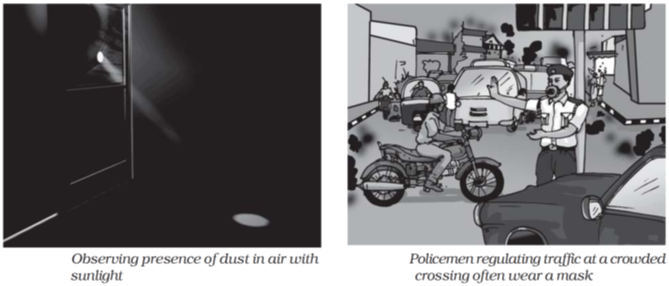- Books Name
- CBSE Class 6 Science Book
- Publication
- Param Publication
- Course
- CBSE Class 6
- Subject
- Science
Activity–3
AIM : To show the presence of dust particles in air.
Method : Close all the doors and windows with curtains pulled down in a sunny room to make the room dark. Now, open the door or a window facing the sun, just a little, in such a way that it allows sunlight to enter the room only through a slit.
We see some tiny shining particles moving in the beam of sunlight.
This shows that air contains dust particles. The presence of dust particles in air varies from time to time, and from place to place.

Note : We inhale air when we breathe through our nostrils. Fine hair and mucus are present inside the nose to prevent dust particles from getting into the respiratory system.
(v) Inert gases : Inert or noble gases are present in air in very small amount. These do not react with any substance but can be used in many ways.
We may conclude, then, that air contains some gases, water vapour and dust particles. The gases in air are mainly nitrogen, oxygen small amount of carbon dioxide, and many other gases. However, there may be some variations in the composition of air from place to place. We see that air contains mostly nitrogen and oxygen. In fact, these two gases together make up 99% of the air. The remaining 1% is constituted by carbon dioxide and a few other gases, water vapour and dust particles.
AVAILABILITY OF OXYGEN TO ANIMALS AND PLANTS LIVING IN WATER AND SOIL
The animals and plants living in water take in the oxygen dissolved in water.
The presence of dissolved oxygen in water can be felt by a simple experiment.
Activity–4
AIM : To show respiration of animals and plants in water and soil.
Material required : (i) water (ii) burner (iii) tripod stand (iv) lump of dry soil
Mathod : Take some water in a beaker and heat it slowly on a tripod stand. Heat it before it begins to boil. Now carefully look at the inner surface of the beaker. We see tiny bubbles on the inside.
These bubbles come from air dissolved in water when we heat it, the air dissolved in it begins to escape and we see bubbles in water.
The organisms that live in soil also need oxygen to respire. If we take a lump of dry soil in a beaker and add water in it, we can observe bubbles coming out of soil. This shows the presence of air in soil.
The plants and animals that live inside the soil respire in this air. A lot of burrows and holes are formed in deep soil by the animals living in the soil. These burrows also make spaces available for air to move in and out of soil.
However, when it rains heavily water fills up all the spaces occupied by the air in soil. In this situation animals living in the soil have to come out for respiration.
This is why earthworms come out of soil during rainy season.

 Param Publication
Param Publication
